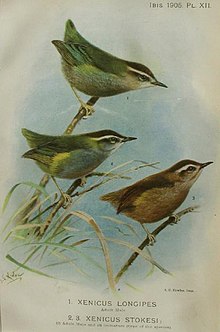Forest panties
| Forest panties | ||||||||||||
|---|---|---|---|---|---|---|---|---|---|---|---|---|

Photo of the nominate form from 1911 |
||||||||||||
| Systematics | ||||||||||||
|
||||||||||||
| Scientific name | ||||||||||||
| Xenicus longipes | ||||||||||||
| ( Gmelin , 1789) |
The forest pantyhose ( Xenicus longipes ) is an extinct species of bird from the stump tail family . It occurred in three subspecies on the North Island and the South Island of New Zealand as well as on Stewart Island and Kapiti Island .
features
The forest panties reached a size of 9 to 10 centimeters and a weight of 16 grams. It was a small, greenish passerine bird with rounded wings. In the nominate form Xenicus longipes longipes , the dark to olive-brown skull was marked with a whitish stripe above the eyes. The top was differently dull olive brown or greenish. The wing feathers had yellowish edges. The stain on the bow was black. The very short tail was olive. The upper throat area was whitish, the underside brownish-gray and the flanks were yellowish. The fine beak was brownish black. The long legs were slate black. The feet were light brown.
The sexes looked the same. Little is known about the young birds; apparently they looked like dull-colored adults, with fine light-colored strands on the top and light-colored underside. Little is known about the breed Xenicus longipes stokesii . It appeared to be more bluish on the neck and chest than the nominate shape. A light yellow stain could be seen on the flanks. The subspecies Xenicus longipes variabilis was more brownish than the nominate form. The over-eye streak was duller and less pronounced. The voice consisted of low trills and rasping calls.
habitat
Located mostly at higher altitudes habitat consisted of illusory beeches dominated beach woods, Podocarpus -Laubwäldern, coastal forests, as well as bushland.
food
The food of the forest slipper consisted mainly of arthropods , often of beetles , which were mostly collected from leaves, twigs, crevices or epiphytes . It would often search for food on the forest floor and move quickly through leaves, mosses or lichens.
Reproduction
Little is known about the breeding behavior. The breeding season was between November and December. The nest was a ball of fern leaves and roots padded with feathers. It was mostly located near the ground in cavities, but sometimes also in a fork of a branch. A nominate-shaped nest found was bag-shaped. The clutch consisted of two eggs. Both parents shared the hatchery and the rearing of the young.
die out
The forest panties became extinct in the 20th century as a result of habitat destruction and the pursuit of predatory predators such as martens and feral cats as well as rats. The only verified evidence of the North Island subspecies X. l. stokesii since 1900 occurred on Kapiti Island in 1911, in the southern Remutaka Range in 1918 and most recently in 1955 near Lake Waikaremoana . Another possible sighting is said to have occurred on June 13, 1949 near Lake Waikareiti and some unconfirmed sightings in the Huiarau Range in the first half of the 20th century . There are only three specimens of this taxon in the museum collections.
The nominate form X. l. longipes was once common all over the South Island . After the colonization of New Zealand by the Europeans in the 19th and 20th centuries, the population decreased so rapidly that the forest slipper was very rare as early as 1950. The last evidence was found in 1966 at Arthur's Pass and in January 1968 in Nelson Lakes National Park , where two specimens were observed.
The subspecies X. l. variabilis was still widespread on Stewart Island and its neighboring islands in the 1930s. The last confirmed sighting on Stewart Island was in 1950 and the last unconfirmed sighting in 1951. In 1961 the breed was only found on Big South Cape Island. To save this subspecies from extinction, six specimens were brought to the nearby island of Kaimohu. In 1964, the population on Big South Cape Island was wiped out by house rats . The last confirmed records date from 1967 and 1972. Despite intensive searches since 1977, the taxon was no longer detected and in 2000 was declared extinct by BirdLife International .
literature
- Del Hoyo, J .; Elliot, A. & Christie D. (Editors) (2004): Handbook of the Birds of the World. Volume 9: Cotingas to Pipits and Wagtails . Lynx Edicions. ISBN 84-87334-69-5
- Fuller, Errol: Extinct Birds. 2000, ISBN 0-8160-1833-2
- Dawson, EW (1951): Bird Notes from Stewart Island. Notornis 4 (6): 146-150. PDF full text
- Edgar, AT (1949): Winter Notes on NZ Birds. New Zealand Bird Notes 3 (7): 170-174. PDF full text
- Miskelly, Colin (2003): An historical record of bush wren ( Xenicus longipes ) on Kapiti Island. Notornis 50 (2): 113-114. PDF full text
- St. Paul, R. & McKenzie, HR (1977): A bushman's seventeen years of noting birds. Part F (Conclusion of series) - Notes on other native birds. Notornis 24 (2): 65-74. PDF full text
Web links
- 3D view of the RMNH 110,000 specimen in the Naturalis Museum , Leiden (requires QuickTime ).
- Photograph of a forest slipper
- Xenicus longipes inthe IUCN 2013 Red List of Endangered Species . Listed by: BirdLife International, 2012. Retrieved September 9, 2013.

